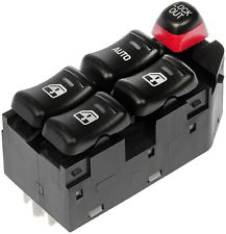SLIA086A June 2014 – December 2021 DRV5013 , DRV5013-Q1 , DRV5023 , DRV5023-Q1 , DRV5033 , DRV5033-Q1 , DRV5053 , DRV5053-Q1
4.1 Design Example with Digital Hall Sensors
Consider the switches used to control power windows in a vehicle.

Each rocker switch could contain two small magnets for the forward and backward directions, along with a digital Hall sensor mounted below each one. This ensures that when the button is not pushed, the B-field at the sensor is below the min-BRP, and pushing the button brings the B-field at the sensor above the max-BOP. This involves a combination of magnet and sensor selection, considering the distance of separation.
When selecting a DRV5032 switch, there are multiple device versions:
| PARAMETER | MIN | TYP | MAX | UNIT | |
|---|---|---|---|---|---|
| DRV5023DU north responding unipolar output | BOP | –3.9 | –2.5 | -1.2 | mT |
| BRP | –3.5 | –1.8 | –0.9 | ||
| DRV5023DU south responding unipolar output | BOP | 1.2 | 2.5 | 3.9 | |
| BRP | 0.9 | 1.8 | 3.5 | ||
| DRV5023FA, DRV5032FB, DRV5032FC | BOP | ±1.5 | ±3 | ±4.8 | |
| BRP | ±0.5 | ±1.5 | ±3 | ||
| DRV5032FD south responding unipolar output | BOP | –4.8 | –3 | –1.5 | |
| BRP | –3 | –1.5 | –0.5 | ||
| DRV5032FD south responding unipolar output | BOP | 1.5 | 3 | 4.8 | |
| BRP | 0.5 | 1.5 | 3 | ||
| DRV5032AJ | BOP | ±4 | ±7 | ±9.5 | |
| BRP | ±3 | ±5.6 | ±7.5 | ||
| DRV5032ZE | BOP | ±33 | ±47 | ±63 | |
| BRP | ±30 | ±43 | ±58 |
The designer must select the material and size when choosing a magnet. Available materials include ceramics and different ferromagnetic metal alloys, with tradeoffs in flux density, temperature performance, mechanical characteristics, and cost. The physical size of the magnet must be selected to produce the appropriate B-fields at the sensor. Flux concentrators that redirect and amplify the B-field of a magnet are also available.
To determine the B-field a magnet produces, measure it using a gaussmeter (or teslameter). There are several online calculators, and some magnet suppliers specify limited B-field characteristics. The field in a particular system varies based on the materials permeated and potential interactions from nearby components.